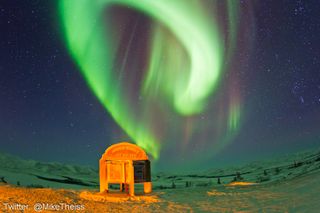Northern Lights Fizzle in US

Those who braved the cold last night trying to catch a glimpse of the northern lights in the continental United States may have been disappointed; the effects of a sun storm bombarding Earth were weaker than expected and did not spark widespread auroral displays in the Lower 48.
But the northern lights did dazzle residents in some parts of northern Europe, such as Norway.
Hopes of aurora sightings were raised after an intense X1.2-class solar flare erupted from the sun earlier this week and a wave of plasma known as a coronal mass ejection, or CME, headed towards Earth. Solar particles from these blasts can trigger geomagnetic storms and auroras when they interact with Earth's magnetic field.
The CME hit Earth Thursday (Jan. 9) around 3:00 p.m. EST (20:00 UTC), Spaceweather.com reported. But by the time it was dark over North America, the lights that had danced over parts of Europe had faded. The effects of the solar storm also were weaker than expected, failing to produce widespread geomagnetic storms, which might have brought auroras to lower latitudes.
According to Spaceweather.com, auroras could still be possible in northerly climes on Friday (Jan. 10) as Earth travels through the wake of the CME.
Follow Megan Gannon on Twitter and Google+. Follow us @livescience, Facebook & Google+. Original article on LiveScience.
Sign up for the Live Science daily newsletter now
Get the world’s most fascinating discoveries delivered straight to your inbox.

